Delaware • New Jersey • Pennsylvania
New York • United States of America
- Aquatic Life Designated Use Project
- Bacteria Monitoring
- Biomonitoring Program
- Chlorides Monitoring
- Contaminants of Emerging Concern
- Delaware Estuary Water Quality Monitoring Program
- Dissolved Oxygen and Nutrients
- Modeling
- Other Monitoring (e.g., Toxicity, Fish Tissue, Metals)
- PCBs and PMPs
- Special Protection Waters (SPW)
- Water Resource Data Sets
- Introduction
- DRBC Study - Monitoring Near-Shore Bacteria Levels: 2019 - 2022
- Looking Ahead: Primary Contact Recreation for the Entire River
- Additional Resources/Links to Learn More
Bacteria: A Water Quality Concern
Elevated concentrations of bacteria in the water can make humans sick if they come into contact with it. This is especially a concern for folks who recreate in the waters of the Delaware River Basin: swimming, kayaking, fishing and boating.
To maintain water quality in the Delaware River that is protective of recreation, the DRBC has adopted criteria for bacteria - fecal coliform and enterococcus. These criteria are part of the DRBC's Water Quality Regulations.
Causes of Elevated Bacteria Levels:
-
- Stormwater runoff, sanitary sewer overflows and/or combined sewer overflows during and after heavy rains
- Runoff from upstream sources during extreme wet weather events
- Animal sources such as Canada geese
- Stormwater runoff, sanitary sewer overflows and/or combined sewer overflows during and after heavy rains
Recreation Designated Uses
DRBC's Water Quality Regulations include criteria to protect the Delaware River's designated uses, one of which is recreation. "Swimmable" waters is also a defined goal of the Clean Water Act.
Two Types of Recreation are Defined Designated Uses:
-
- Primary contact recreation, such as swimming
- Secondary contact recreation, such as fishing and boating
- Primary contact recreation, such as swimming
Primary contact activities allow for closer contact with the water than secondary; therefore, primary contact recreation waters have stricter bacteria criteria.
What Parts of the Delaware River are Primary Contact vs. Secondary Contact Recreation?
- For almost the entire mainstem Delaware River, the river's designated use is for primary contact recreation.
- However, for a 27-mile stretch of the Delaware River around Philadelphia and Camden, known as DRBC Water Quality Zone 3 and upper Zone 4, the river's designated use is for secondary contact recreation.
Monitoring Bacteria in the Delaware River
DRBC staff monitors bacteria levels in surface water to see if harmful bacteria are present and to ensure water quality criteria are being met.
- Since 1967, bacteria data are collected once monthly from March - October through the DRBC's Delaware Estuary Water Quality Monitoring Program, which collects samples from the river's center channel.
- The DRBC has completed a multi-year, special bacteria monitoring study to assess whether current water quality criteria supports primary contact recreation in Zones 3 and upper Zone 4. This study focused on near-shore bacteria levels, which is where most folks would be recreating and would complement the existing long dataset for the center channel. More information on this study is below.
Watch DRBC Staff Sample for Bacteria: Penn's Landing Lagoon, August 2020
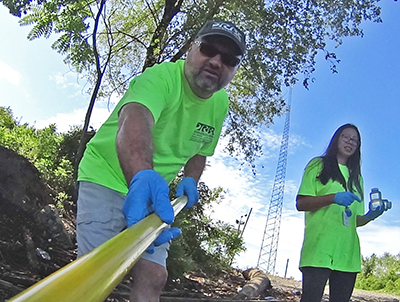 |
| DRBC Mgr. of Water Quality Assessment John Yagecic and Water Quality Intern Daisy DePaz collect a surface water sample to monitor for bacteria levels in 2019. Photo by the DRBC. |
Why Study Near-Shore Bacteria Levels?
Around Philadelphia and Camden, the river's designated use is for secondary contact recreation.
In order to determine whether water quality would support primary contact recreation, in 2019 the DRBC initiated a focused bacteria monitoring effort in this urban stretch of the tidal Delaware River.
Data collection was focused near-shore, which is where folks would mainly be recreating. These data will complement the center-channel data already being collected once monthly from March - October.
Data were collected at the following locations
• In New Jersey: Pyne Point Park, National Park, Pennsauken Access, Palmyra Cove and Riverton Yacht Club
• In Pennsylvania: Penn Treaty Park (closed in 2019), Washington Ave. Green, Penn's Landing and Frankford Arsenal Access
Samples will be analyzed for E. coli, fecal coliform and enterococcus.
2019 Monitoring
DRBC sampled five times a month during May - September 2019 from five access points in New Jersey and three in Pennsylvania.
Samples were collected after heavy rains and during drier periods.
• View Map of Sampling Locations (jpg 439 KB)
2020 Monitoring
Sampling in 2020 got a delayed start due to COVID-19 mitigation measures. Samples started being collected in July at the same locations as in 2019 (see map linked above), with the addition of Penn Treaty Park in Pa., which was closed for construction in 2019. A total of nine locations were sampled during July, August and September.
2021 Monitoring
In 2021, data collection at the nine shore-based locations sampled in 2020 continued.
• View map of sampling locations (png)
The DRBC also collected data via boat.
• Boat-Based, Center-Channel: via the Delaware Estuary Water Quality Monitoring Program
• Boat-Based, Transect: Five transects, five samples each: Chester, Red Bank, Penn's Landing, Pyne Poynt Park and Frankford Arsenal
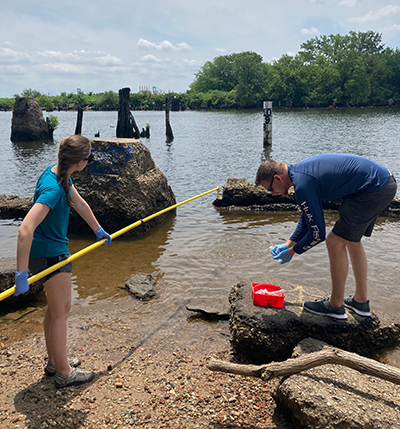 |
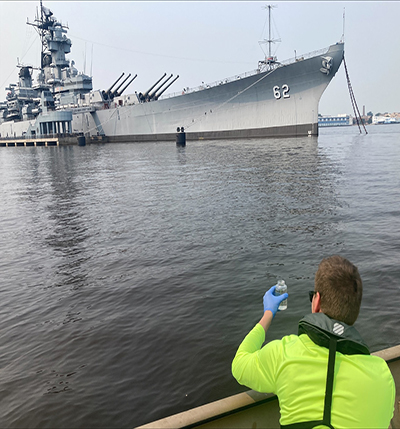 |
| DRBC Water Quality Interns Bailey Adams ( far L) and Kyle McAllister collect water samples from the Delaware River to monitor bacteria levels. Photo by DRBC. |
|
Installation of Real-Time Bacteria Monitor with USGS: 2021 & 2022
In 2021, DRBC partnered with the U.S. Geological Survey (USGS) to install an advanced next generation water-quality instrument to monitor bacteria indicators in Camden County’s Pyne Poynt Park, in Camden, N.J.
The Fluidion Alert System - one of the first in the nation - advances DRBC, USGS and the Basin community’s knowledge of the changing water quality in the urban Delaware River Estuary. It does this by providing near real-time bacterial data. The System can remotely sample on demand and provide results the same day, rather than the typical three days traditional sampling methods take.
Data collected from the Fluidion system will help water resource managers and local officials make timely, data-based decisions about water quality and public health, for example, are river conditions currently safe for recreation. Funding for the Fluidion Alert System was generously provided by the U.S. EPA Urban Waters Federal Partnership and The William Penn Foundation.
The System was removed in advance of the winter season and was reinstalled at the same location in May 2022. It was removed in the Fall 2022.
- View News Release (2021)
- Learn more: USGS & DRBC Collaborate to Monitor Bacteria Levels in Camden's Pyne Poynt Park (2022)
 |
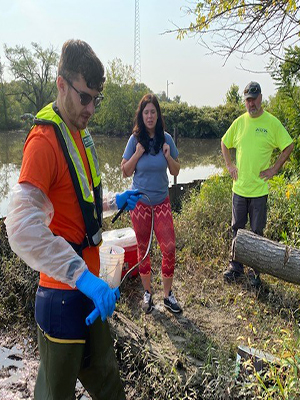 |
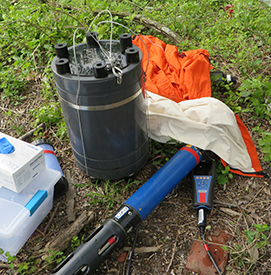 |
| The site location for the Fluidion Alert System. Photo by the DRBC. |
USGS staff perform routine maintenance on the Fluidion monitor. DRBC's Elaine Panuccio and John Yagecic check out the process. Photo by the DRBC. | The Fluidion Alert System. Photo by the DRBC. |
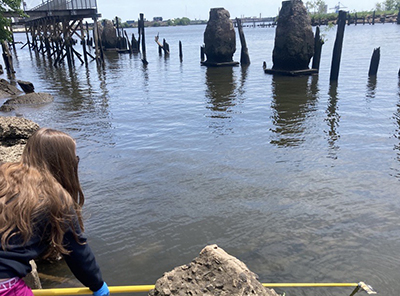 |
| DRBC staff collects a sample to monitor bacteria levels in the Delaware Estuary. Photo by the DRBC. |
2022 Monitoring
In 2022, data collection at the nine shore-based locations sampled in 2020 & 2021 continued, as well as via the Delaware Estuary Water Quality Monitoring Program. The DRBC also collected data to differentiate between sources of bacteria pollution, known as microbial source tracking.
Microbial Source Tracking
• 3 wet weather and 3 dry weather sampling events at each of the nine shore-based sampling locations.
• Goal is to differentiate bacteria derived from humans, cows, horses, Canada geese, deer and dogs
• Data analysis by the New Jersey Center for Water Science and Technology at Montclair State University
• Resolution for the Minutes regarding Microbial Source Tracking (approved by the DRBC in Dec. 2021)
As mentioned above, nearly all of the Delaware River is designated for primary contact recreation - except for a 27-mile stretch around Philadelphia and Camden, which is designated for secondary contact recreation.
DRBC Near-Shore Bacteria Study Results
The monitoring results from the DRBC's Near-Shore Bacteria Study indicate that water quality in this 27-mile stretch of urban river does not meet the criteria for primary contact recreation. However, some sites could be closer to attaining criteria than others.
Ongoing Projects, Next Steps
Despite these results, the DRBC fully supports the goals of the Clean Water Act, including the goal to achieve "swimmable" waters - primary recreation - throughout the entire Delaware River.
The DRBC's recreational uses co-regulator work group, which includes representatives from the U.S. EPA, PADEP, NJDEP and DNREC, continues to examine the issue and is working to develop and execute a strategy for addressing enhanced recreational uses in Zones 3 and upper 4. The strategy includes near term activities (5 years) and long-term activities, which the DRBC and its co-regulators will work through before designating primary contact recreation as the applicable recreation use for Zones 3 and upper Zone 4 of the Delaware Estuary.
Several near term activities have been completed or are underway. These include:
- Additional data collection to determine the relationship between wet weather events and bacteria loadings, the prevalence of different sources of bacteria and which areas are more or less likely to support primary contact recreation.
- Development of water quality models to simulate current and projected bacteria loads.
- Reviewing studies completed by partners on recreation hazards (Philadelphia Water Department study) and on bacteria sources and remediation opportunities (Water Center at Penn study - more below).
Despite the long-term nature of the infrastructure investment needed to achieve "swimmable" waters by significantly reducing bacteria loadings, the DRBC and its co-regulators have an aligned interest in making continued improvements in water quality in the urban estuary and providing additional opportunities for safe and equitable recreational uses. The DRBC will continue to coordinate with its Water Quality Advisory Committee regarding data assessment and next steps. Meetings of the Water Quality Advisory Committee are open to the public.
Monitoring 2024-2025
- In 2024, the DRBC targeted monitoring before, during and after three rain events at five sites to track trends. These five sites - Betsy Ross Bridge, Ben Franklin Bridge, Navy Yard, Paulsboro and Eddystone - are part of the Delaware Estuary Water Quality Monitoring Program.
- In summer 2024, the DRBC partnered with the PADEP to monitor ~88 sites (transects, single locations and tidal tributaries) in the Delaware Estuary. In summer 2025, DRBC and PADEP will monitor ~70 sites in the tidal and non-tidal Delaware River.
- The DRBC is also working with the NJDEP in 2024 to collect samples at ~46 sites to monitor for bacteria.
As time and funding allow, DRBC plans to do a pilot study to monitor for Antimicrobial Resistance (AMR). This is when bacteria become resistant to drugs such as antibiotics, making infections harder to treat. Aquatic environments can spread these drug-resistant pathogens. DRBC staff will develop a monitoring plan and conduct targeted monitoring, first in the populated urban corridor.
Water Center at Penn Study
In January 2024, The Water Center at Penn published its Delaware River Bacteria Study, which looked at existing data and limiting factors to achieving "swimmable" water quality in this urban stretch of river. The project will ultimately develop policy options for consideration that will improve recreational access for local communities. The DRBC is a project partner. Learn more at the link below.
Elevated Bacteria Notification/Alert Systems
- The Philadelphia Water Department (PWD) created a Public Notification System for Combined Sewer Overflows to keep the public informed of when these occur.
- PWD also utilizes the Philly River Cast for the Schuylkill River to alert the public whether the river is safe or unsafe for recreation.
- Learn more about PWD & Watershed Protection
DRBC Presentations
- Proposed Bacteria Criteria Updates (pdf; given at the December 2025 meeting of the Water Quality Advisory Committee)
- Delaware Estuary Recreational Uses: Updates and Status (pdf; given at the April 2024 meeting of the Water Quality Advisory Committee)
- Recreational Uses Update (pdf; given at the May 2022 meeting of the Water Quality Advisory Committee)
- Restoring Water Quality in the Main Stem Delaware River: Programs, Policies and Strategies (pdf; given at the 2021 Annual Delaware River Watershed Forum)
- A Fishable, Swimmable (and Drinkable) Delaware River Estuary (pdf; given at the 2020 Annual Delaware River Watershed Forum)
- Recreation Uses in the Estuary - 2019 Bacteria Sampling Results (pdf; given at the April 2020 meeting of the Water Quality Advisory Committee)
- Recreational Uses and Criteria in the Delaware River (pdf; given at the 2019 Annual Delaware River Watershed Forum)
Copyright © Delaware River Basin Commission,
P.O. Box 7360, West Trenton, NJ 08628-0360
Phone (609)883-9500; Fax (609)883-9522
Thanks to NJ for hosting the DRBC website